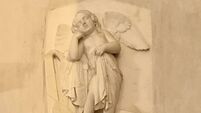Whooper swans trumpet their arrival
Jim Wilson in his recent book Freshwater Birds of Ireland describes it as being like an out-of-tune wind instrument. I think this is a little harsh because for me it’s one of the most beautiful of all bird calls. I looked up and 30 or 40 whooper swans were flying overhead in a V formation.
An estimated 12,500 whooper swans spend the winter in Ireland. They come from western Iceland to Ireland and western Scotland. Birds from eastern Iceland spend the winter in eastern Scotland and southern Scandinavia. When the Irish birds first arrive they congregate in large flocks on Lough Foyle and Lough Swilly. Later in the winter they break up into groups, like the one I saw the other day, and head further south. Most of them leave again in March or early April.














